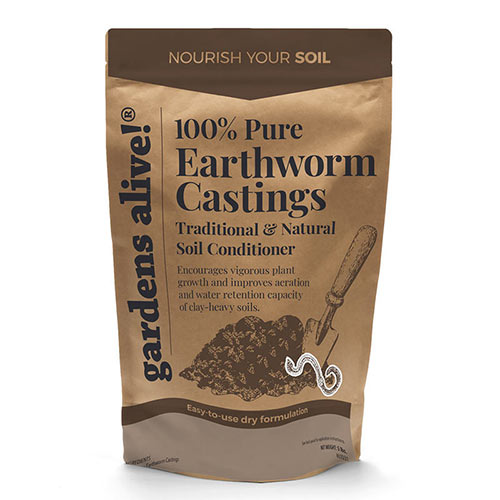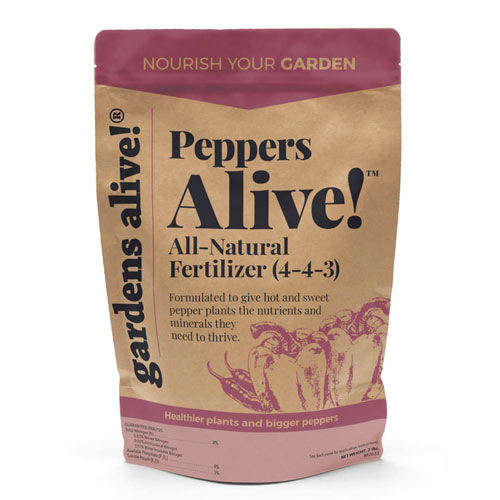Carolina Reapers: They Are HOT< HOT< HOT!
But They Themselves Don't Like That Level of Heat
-
Helpful Products from Gardens Alive!
-
 100% Pure Earthworm Castings - Natural Soil Conditioner
100% Pure Earthworm Castings - Natural Soil Conditioner -
 Peppers Alive!™ Fertilizer
Peppers Alive!™ Fertilizer
Q. Back in early October, Gabriel in Ozark, Missouri wrote: "I have a young Carolina Reaper pepper plant that started budding back in July and August. There were around two or three dozen buds early on. But over the last month or so, I started noticing buds that had been 'liberated' from the plant at the stem of the bud. I presumed a pest of some sort was gnawing them off. I put a fine mesh screen over the plant, and that seemed to help slow the bud loss. However, buds are still dropping off. I have had just one ripe fruit so far!
"What could be causing the buds to liberate, and how can I mitigate or eliminate this problem? Again, the buds are liberated but not eaten. I have attached two photos; one shows five 'liberated' buds lying on the soil; the other shows an overall photo of the plant."
A. First, I want to warn everyone out there that this pepper is not for eating; as the comedy troupe Monty Python once said, "it is for lying down and avoiding". Coming in at a seriously scorching one million, six hundred thousand Scoville Units (a measure created to 'score' the hotness of hot peppers) it was once judged to be the hottest hot pepper in the world, but is now being challenged by breeders who claim their new entries reach well over two million units.
This is madness! In comparison, tasty jalapenos measure in at two to eight thousand units; now that's a pepper you can enjoy without risk of chemical mouth burns! The once-feared Scotch Bonnet now seems mild at 100,000 units; and the legendary hotter-than-Hades habanero is "only" 250,000 units. Once you get up near a million, you're talking about stripping the paint off your esophagus.
I quote from a 2020 article in the journal Radiology Case Reports (an NIH [National Institutes of Health] publication) titled "Fear the Reaper":
"The Carolina Reaper is one of the spiciest edible peppers in the world. Similar in size to the habanero, these bright red little peppers are commercially available in raw form as well as seeds, dried peppers, and flavoring for sauces. Hot pepper eating contests have grown in popularity and often feature ingestion of raw Carolina Reaper peppers as the pinnacle challenge.
While localized symptoms such as mouth burning and mouth numbness are the main risks of eating these peppers, recent case reports have revealed more serious complications of these potent foods. Reversible cerebral vasoconstriction syndrome (shutting off blood to the brain), myocardial infarction (heart attack), and esophageal rupture have all been reported."
OK--you have been warned. Now to address Gabe in the Ozarks' question. (Remember Gabe?)
Aborted fruiting (meaning that the flower made it thru okay, but it all went blahooey after that) is surprisingly common with hot peppers. Although we tend to think they prefer Arizona-like weather in the summertime (when area humans have to dig deep caves and live under the sand for months at a time), they actually grow best at temps between 75- and 85-degrees F. And they DESPISE temps below 50 F.
They don't mind drying out once in a while, but they hate being overwatered, which may be the number one source of the kind of stress that causes premature fruit drop.
That's right: Plant stress. As deadly to peppers as it is to humans, stress can cause heart attacks (as can eating one of these little hand grenades; just saying) and other bad things and just make your life seem more awful than it really is. (Of course, this depends on your actual life; individual results will vary.)
It's not that this plant is unusually temperamental (remember that tomato flowers will fail to produce fruit when temps reach the nineties), most hot peppers feel the same. Stress is stress and plants don't like it any more than we do.
Let's get specific. One of Gabriel's photos reveals a splendid looking pepper plant, with the exception of it not having any actual peppers. As I always try to stress (oops; wrong word! Ahem: "remind you all") healthy leaves are a sure sign that disease, insects and/or sunspots are not to blame. That leaves cultural conditions.
If, like Gabe, you have pepper plants in pots, bring them inside before monsoon rains arrive and put them back out afterwards. If midday temps are predicted to approach the average reading on Mercury or Venus, bring the plants inside until the heat breaks. If the plants are in the ground and you have advance warning, pot them up. Do not have saucers under your pots; they are guaranteed to produce too-much-water stress.
Don't feed peppers (or other fruiting plants) with a lot of Nitrogen. You'll get big plants with lots of leaves and few fruits (and/or fruits that fall off early in the game).
Plants fed with compost or worm castings will flourish. Plants fed with repurposed explosives (like Miracle-Gag) will always be stressed by the unnatural growth these "fertilizers" cause.
If you grow in a coolish clime, give the plants all the sun possible. If you grow in an area with torrid summertime temps, try to plant where they will receive full morning sun and get a shady break in the afternoon. Think shade cloth and/or beach umbrellas if you can't achieve this naturally.
"What could be causing the buds to liberate, and how can I mitigate or eliminate this problem? Again, the buds are liberated but not eaten. I have attached two photos; one shows five 'liberated' buds lying on the soil; the other shows an overall photo of the plant."
A. First, I want to warn everyone out there that this pepper is not for eating; as the comedy troupe Monty Python once said, "it is for lying down and avoiding". Coming in at a seriously scorching one million, six hundred thousand Scoville Units (a measure created to 'score' the hotness of hot peppers) it was once judged to be the hottest hot pepper in the world, but is now being challenged by breeders who claim their new entries reach well over two million units.
This is madness! In comparison, tasty jalapenos measure in at two to eight thousand units; now that's a pepper you can enjoy without risk of chemical mouth burns! The once-feared Scotch Bonnet now seems mild at 100,000 units; and the legendary hotter-than-Hades habanero is "only" 250,000 units. Once you get up near a million, you're talking about stripping the paint off your esophagus.
I quote from a 2020 article in the journal Radiology Case Reports (an NIH [National Institutes of Health] publication) titled "Fear the Reaper":
"The Carolina Reaper is one of the spiciest edible peppers in the world. Similar in size to the habanero, these bright red little peppers are commercially available in raw form as well as seeds, dried peppers, and flavoring for sauces. Hot pepper eating contests have grown in popularity and often feature ingestion of raw Carolina Reaper peppers as the pinnacle challenge.
While localized symptoms such as mouth burning and mouth numbness are the main risks of eating these peppers, recent case reports have revealed more serious complications of these potent foods. Reversible cerebral vasoconstriction syndrome (shutting off blood to the brain), myocardial infarction (heart attack), and esophageal rupture have all been reported."
OK--you have been warned. Now to address Gabe in the Ozarks' question. (Remember Gabe?)
Aborted fruiting (meaning that the flower made it thru okay, but it all went blahooey after that) is surprisingly common with hot peppers. Although we tend to think they prefer Arizona-like weather in the summertime (when area humans have to dig deep caves and live under the sand for months at a time), they actually grow best at temps between 75- and 85-degrees F. And they DESPISE temps below 50 F.
They don't mind drying out once in a while, but they hate being overwatered, which may be the number one source of the kind of stress that causes premature fruit drop.
That's right: Plant stress. As deadly to peppers as it is to humans, stress can cause heart attacks (as can eating one of these little hand grenades; just saying) and other bad things and just make your life seem more awful than it really is. (Of course, this depends on your actual life; individual results will vary.)
It's not that this plant is unusually temperamental (remember that tomato flowers will fail to produce fruit when temps reach the nineties), most hot peppers feel the same. Stress is stress and plants don't like it any more than we do.
Let's get specific. One of Gabriel's photos reveals a splendid looking pepper plant, with the exception of it not having any actual peppers. As I always try to stress (oops; wrong word! Ahem: "remind you all") healthy leaves are a sure sign that disease, insects and/or sunspots are not to blame. That leaves cultural conditions.
If, like Gabe, you have pepper plants in pots, bring them inside before monsoon rains arrive and put them back out afterwards. If midday temps are predicted to approach the average reading on Mercury or Venus, bring the plants inside until the heat breaks. If the plants are in the ground and you have advance warning, pot them up. Do not have saucers under your pots; they are guaranteed to produce too-much-water stress.
Don't feed peppers (or other fruiting plants) with a lot of Nitrogen. You'll get big plants with lots of leaves and few fruits (and/or fruits that fall off early in the game).
Plants fed with compost or worm castings will flourish. Plants fed with repurposed explosives (like Miracle-Gag) will always be stressed by the unnatural growth these "fertilizers" cause.
If you grow in a coolish clime, give the plants all the sun possible. If you grow in an area with torrid summertime temps, try to plant where they will receive full morning sun and get a shady break in the afternoon. Think shade cloth and/or beach umbrellas if you can't achieve this naturally.
-
Helpful Products from Gardens Alive!
-
 100% Pure Earthworm Castings - Natural Soil Conditioner
100% Pure Earthworm Castings - Natural Soil Conditioner -
 Peppers Alive!™ Fertilizer
Peppers Alive!™ Fertilizer







 Gardens Alive! & Supplies
Gardens Alive! & Supplies




